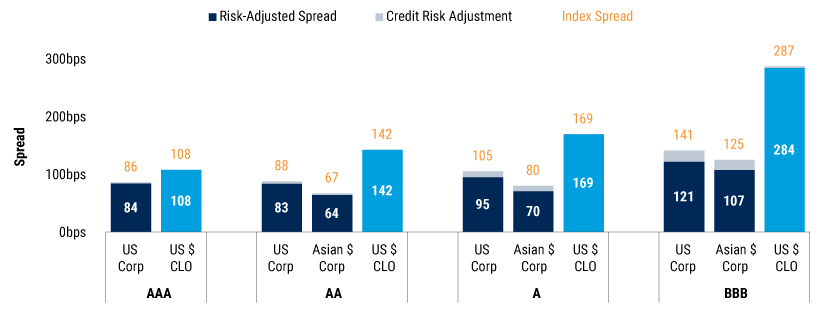Capital Framework Reform Opens the Door to CLO Investing for Singapore Insurers

Vladimir Zdorovenin, PhD
Head of International Insurance Solutions

Laila Kollmorgen, CFA
Global Head of CLO Tranche Investments, Portfolio Manager
The Monetary Authority of Singapore (MAS) has finalized changes to the capital treatment of structured products and infrastructure investments for insurers, following its October 2024 public consultation. The new rules are expected to take effect on 31 March 2026.
The revisions will lead to lower capital requirements for most investments in credit securitizations, including collateralized loan obligations (CLOs), as well as streamlined capital calculations.
Lower capital requirements will remove a key barrier for investments in securitized credit, opening the door for Singapore insurers to access an asset class that has long been underrepresented in their portfolios.
Improved capital efficiency could make CLOs, which offer wider spreads and historically lower default rates versus comparable corporate bonds, a compelling addition to insurers’ fixed income allocations.
To unlock the full potential of securitization investments, insurers must be able to identify, measure, monitor, control, and report on the risk of their investments. The complexity of structured credit and the need for insurance-specific investment KPIs mean that active security selection and rigorous risk management are essential.

On 28 October 2025, the Monetary Authority of Singapore published its response to public consultation on the proposed capital treatment for structured products and infrastructure investments for insurers.1 The amended capital treatment is expected to take effect from 31 March 2026 .
Under the current regulation,2 insurers face the choice between painstakingly deriving the capital charges for individual tranches based on look-through to the underlying pool of collateral and then adding a 50% loading to account for volatility and illiquidity risk of structured products – an option that is hardly practical for actively managed securitized credit portfolios – or carrying a punitive 50% capital charge, in line with the capital charge for private equity investments.
Under the proposed reform, insurers will calculate the credit spread risk capital requirement for investments in securitized products based on external credit ratings assigned to securitization tranches, the same as for other debt investments.3 Debt-based securitizations (such as CLOs) will continue to carry an additional 50% loading on the market-related risk requirement (i.e., excluding interest rate and currency mismatch risks). For non-debt-based securitizations (such as securitizations of private equity fund stakes), the additional loading will be set at 300% (for investment grade rated tranches) to 500% (for non-investment-grade tranches). The use of internal credit ratings will not be allowed for structured products.
The reform brings a significant improvement in the regulatory capital efficiency of investments in debt-based securitizations, including CLOs. Our analysis of current market spreads and anticipated capital requirements demonstrates that on a relative value basis, the spread pickup over comparable corporate bonds will make CLOs an attractive addition to insurers’ fixed income portfolios, despite the 50% loading on credit spread risk capital requirements – and that the “CLO advantage” holds across the full spectrum of credit ratings.
Relative Value: Spreads on Investment-Grade USD CLO Tranches vs. Corporate Bonds

Regulatory Capital Efficiency: Risk-Adjusted Spread on Spread Risk Capital

Source: PineBridge Investments analysis based on ICE Index Platform and JPMorgan (as of 31 October 2025), Moody’s (as of 4 August 2025), and PineBridge Investments interpretation of Monetary Authority of Singapore (28 October 2025) ID 13/25 Response to Consultation Paper on Proposed Capital Treatment for Structured Products and Infrastructure Investments for Insurers and MAS Notice 133: Valuation and Capital Framework for Insurers (as amended on 14 June 2024).
“Spread” is bond index Swap OAS or CLO index Discount Margin (To Worst – Simple Average). “Risk-Adjusted Spread” is Spread adjusted for credit risk; the risk adjustment is a PineBridge Investments assumption informed by historical credit losses on global corporate debt and CLOs estimated from Moody’s long-term default and recovery statistics. “Capital Efficiency” is the ratio of Spread to Singapore RBC 2 capital requirement for credit spread risk estimated by PineBridge Investments based on index ratings and durations.
The reform also creates a more even playing field for Singapore insurers vis-à-vis their regional and global peers. Prohibitive capital treatment of investments in structured products has effectively barred most Singaporean insurers from making meaningful allocations to securitized credit. At the same time, securitizations account for 15% of total investments for insurers in the US4 and 17% in Bermuda.5 The regulatory shift by the MAS creates an opportunity for Singaporean insurers to narrow the gap with their global peers and build better-diversified, higher-yielding portfolios by engaging with high-quality securitized credit across public and private markets.
Why CLOs make sense for insurance portfolios
Historically, CLO tranches have offered investors an attractive risk-return profile, rewarding them for taking on complexity rather than default risk. On average, from 1993 to 2024, the five-year cumulative loss rate for CLO tranches rated investment grade at origination was 4 basis points (bps) (compared to 78 bps for speculative grade tranches),6 whereas the comparable long-term average for investment grade corporate bonds was over 50 bps.7
The floating-rate coupon also means that CLO tranches can diversify insurers’ portfolios, which largely comprise longer-dated fixed rate bonds. This can be particularly beneficial in periods of elevated interest rate volatility, such as during the post-Covid interest rate hikes of 2022-2023.
Further Reading
For more on why CLOs could be a good addition to insurers’ investment portfolios, see PineBridge’s earlier publication “The Case for Collateralized Loan Obligations for Global Insurers.”
Active portfolio management and robust risk management are key
While regulatory capital efficiency is a key consideration for insurance investors, additional dimensions of complexity must also be addressed when expanding an insurer’s investment strategy to incorporate a new asset class. These include diversification with existing assets and liabilities on a specific insurer’s balance sheet, asset-liability management, liquidity and income planning, and accounting treatment of new investments.
Singapore insurers face a high bar in managing their investments: MAS Notice 125 stipulates that insurers should only invest in assets whose risks they can identify, measure, monitor, control, and report. Against this complex backdrop, an active approach to security selection and risk management is essential — enabling investors to take only the intended risks while effectively managing them throughout the investment lifecycle.
We believe the revised capital treatment will help unlock a compelling market for securitization investments – offering Singaporean insurers an opportunity to build better-diversified, higher-yielding fixed income portfolios.
1 Monetary Authority of Singapore (28 October 2025) ID 13/25 Response to Consultation Paper on Proposed Capital Treatment for Structured Products and Infrastructure Investments for Insurers.
2 PineBridge Investments interpretation of Appendix 4G of MAS Notice 133: Valuation and Capital Framework for Insurers (as amended on 14 June 2024).
3 Under the current regulation, only the Big 3 rating agencies (Fitch, Moody’s, Standard & Poor’s) and A.M. Best are recognized as external credit assessment institutions (“ECAI”) for the purpose of risk-based capital calculations. The process for recognition of additional ECAIs is laid out in MAS Notice 133 Appendix 4I.
4 PineBridge Investments interpretation of US NAIC Capital Markets Bureau Special Report (2 May 2025) U.S. Insurance Industry’s Cash and Invested Assets Rise Over 5% to Close in on $9 Trillion as of Year-End 2024.
5 PineBridge Investments interpretation of Bermuda Monetary Authority (5 September 2024) Private Credit – Deep dive on Direct Loans, CLOs, and Private Placements. Sum of weighted average allocations to RMBS, CMBS, CLO, and ABS.
6 PineBridge Investments interpretation of Exhibit 39 in Moody’s Ratings (23 June 2025) Impairment and loss rates of structured finance securities: 1993-2024.
7 PineBridge Investments estimate based on 86 bps cumulative five-year default rate for investment grade global corporates (average over the period of 1970-2024) reported in Moody’s Ratings (4 August 2025) US municipal bond default and recovery rates: 1970-2024 and 37.9% average issuer-weighted recovery rate for Sr. Unsecured Bonds (based on trading prices, average over the period of 1983-2024) reported in Moody’s Ratings (27 March 2025) Default Trends – Global: Annual default study: Corporate default rate to fall below its long-term average in 2025.
Disclosure
Investing involves risk, including possible loss of principal. The information presented herein is for illustrative purposes only and should not be considered reflective of any particular security, strategy, or investment product. It represents a general assessment of the markets at a specific time and is not a guarantee of future performance results or market movement. This material does not constitute investment, financial, legal, tax, or other advice; investment research or a product of any research department; an offer to sell, or the solicitation of an offer to purchase any security or interest in a fund; or a recommendation for any investment product or strategy. PineBridge Investments is not soliciting or recommending any action based on information in this document. Any opinions, projections, or forward-looking statements expressed herein are solely those of the author, may differ from the views or opinions expressed by other areas of PineBridge Investments, and are only for general informational purposes as of the date indicated. Views may be based on third-party data that has not been independently verified. PineBridge Investments does not approve of or endorse any republication of this material. You are solely responsible for deciding whether any investment product or strategy is appropriate for you based upon your investment goals, financial situation and tolerance for risk.



